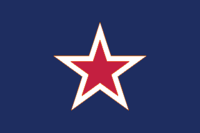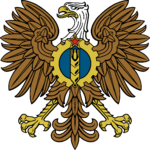The Union Army
| Union Army | |
|---|---|
 Army Flag | |
| Active | 1919-Present |
| Country | Florencia |
| Allegiance | Union Defense Forces |
| Type | Army |
| Role | Land warfare |
| Motto(s) | "The Sword and Shied of the Motherland" |
| Mascot(s) | Lion |
| Anniversaries | December 1 (Army Day) |
| Commanders | |
| Commander-in-chief | Lee Saemin |
| Secretary of Defense | Eo Jaeyeon |
| Commander of the Army | Jeon Bongseok |
| Chief of Staff | Admiral Lee Zachuan |
Born from the fires of revolution, the Union Army is the oldest, largest, and most diversified branch within the Union Defense Forces. In many ways the Union Army is a microcosm of the rest of the military, with their own rocket troops, air defense troops, aircraft, and paratroopers. Originally a loose grouping of patriotic rebels resisting tyranny, the army has grown exponentially in terms of size and power since it's foundation in 1919. The mission of the Army is the defense of Florence's people and territory on the land and air. To fulfill this mission the army maintains extensive garrisons, deploys a wide range of weapons and vehicles, and makes a great use of specialized troops.
History
Structure
The Union Army can be broken down into four autonomous administrative components—the Army Ground Forces (AGF), Army Rear Forces (ARF), Union Army Air Forces (UAAF), and the Air-Descent Forces (ADF). The Army Ground Forces is responsible for the procurement, training, mobilization, and provision of land combat units. Provides the Union Army with "well led, disciplined, trained, and motivated" forces to the strategic directions in order to maintain for the defense of the Florencian Union at home and abroad. The rear forces of the army furnish logistical, technical, and what other special troops do not fit under the other three autonomous components. The Army Rear Forces are a vital link between the nation's economy and the army, as well as an essential service for supplying the needed material, construction, specialists, support and other duties needed for the Union Army to operate efficiently.
Branches of Service
There exist four branches of service within the Union Army. These are not operational components, but rather administrative and training branches tasked with providing soldiers, airmen, equipment, and services to the unified strategic commands. The chief of each service is a branch specific marshal with the exception of the Air Descent Forces. These being titled the Marshal of the Ground Forces, Marshal of the Rear Forces, Air Marshal, and the General of the Paratroopers. Though both the Army Ground and Rear Forces act only as administrative services, both the air forces and air descent forces exercise a large amount of independence and operational authority. This in due part to the differences of having the majority of the UDF's air force subordinate to army command and the unique traditions and esprit de corpsexercised by the airborne troops.
Union Army Ground Forces
The Army Ground Forces is responsible for the training, schooling, and provision of combat capable troops to the unified strategic commands. The Army Ground Forces sees it's mission as training and preparing the Army in accordance with theTotal National Defense Policy adopted by the All-Union Congress in 1977, so that the Union Army may be equipped and prepared to conduct the defense of it's borders and peoples. The Army Ground Forces thus provides what troops are classified as combat arms to division and operational group commanders. Those being; the infantrymen, cavalry scouts, tankers, artillerymen, and air cavalrymen.
Infantry
Armor
Calvary Scouts
Artillery
Air Calvary
Ground Forces Combat Maneuver Units
1st Armored Division "Iron Lions" 2nd Dragoon Division "Jumping Mustangs" 5th Armored Division "Steel Dragons"
4th Armored Calvary RCT "Black Bears" 56th Armored Calvary RCT "Blackjack" 128th Dragoon RCT "Steel Knights"
1st Rifle Division “Vanguards” 2nd Rifle Division “Sykes Regulars” 3rd Rifle Division “Mud Crunchers” 7th Rifle Division “Bayonet” 24th Rifle Division “Victory” 89th Rifle Division “Rolling K” 93rd Rifle Division “Lethal Warriors” 104th Rifle Division "Timberwolf Division"
19th Mountain Division "Silverwolves"
129th Mountain RCT "Fighting Grays" 134th Mountain RCT "Waltzing Mackies" 202nd Rifle RCT "Tough Gents"
11th Air Calvary RCT 12th Air Calvary RCT 50th Air Calvary RCT 55th Air Calvary RCT 56th Air Calvary RCT 133rd Air Calvary RCT
Union Army Rear Forces
The Union Army Rear Forces are intended to provide for the supply and technical support of combatant units. Their origins lay in the Convoy Troops of the Imperial Army during the War of Unification, as well as the various technical services of the Union Army that ultimately came to form the rear forces in 1941. Since their inception the Union Army Rear Forces has been tasked with almost the entire scope of logistics in regards to the Union Army. Rear Forces handle anything from the provision of arms and equipment, washing clothes, or construction bridges. This includes the companies and battalions that would be classified as Division Troops, as well as the sustainment brigades that organic to every operational group. Effectively all miscellaneous soldiers that are not combat arms, air force, or paratroopers are classified under the Union Army Rear Forces. The soldiers of the Rear Forces are apart of seven technical services: Pioneer Corps, Signal Troops, Ordnance Corps, Quartermaster Troops, CBRN Corps, Medical Corps, and the Motor and Rail Troops.
Union Army Air Forces
The aerial warfare component, the Union Army Air Forces are tasked with the overall administration of the military's principle air force in support of ground troops. The debate over the future of the air force within the Defense Forces led to the fracturing of the independent air force and the re-acquisition of frontal, long range, and material aviation responsibility by the Army Air Forces. An extensive fleet of attack planes, multi-role fighters, swept-wind or four engine turboprop bombers, light and heavy transport movers, and rotary assets fall under the administration of the Union Army Air Forces, in addition to self propelled artillery anti-air assets. Army Air Forces' assets and personal fall into the five component categories of Rotary Aviation, Frontal Aviation, Long Range Aviation, Material Aviation, and Artillery Anti-Air.
While in theory the Union Army Air Forces are a subordinate command within the Union Army and responsible just for the administration, provision, and training of airmen and assets, since it's inception in 1942 the UAAF has continually sought to expand it's independence. Though frontal aviation assets and helicopters are generally subordinate to unified combatant commanders, long-range aviation and material transportation assets fall under their own command separate of ground forces and the other branches of the Defense Forces. Those being the Strategic Air Command and Material Air Command respectively. This near-independence is further exemplified by the Army Air Forces inter-service relationship with the Air Defense Forces of the Republics. Which given the fact tactical pursuit and interceptor aviation are separated under two separate branches, this cooperation makes sense.
Air-Descent Forces
Well motivated volunteers with superior training, the Air-Descent Forces are some of the best troops in the army. The Union's airborne forces are unique among contemporary opponents for featuring several fully motorized air-deployable units, as well as retaining heavy firepower not always associated with the airborne. However, other divisions of the airborne troops are organized more similar to their global counterparts. This gives the Union Army a unique force of soldiers capable of paradropping behind enemy lines and acting as a near guerrilla force, or as a premier maneuver shock force able to both seize ground and hold it until reinforcement. Like the Army Air Forces, the Air-Descent Forces garner an aspect of near-independence unseen in the ground and rear forces. While nominally tasked with the administration and schooling of paratroopers, the General of the Air-Descent forces also holds command over the 18th Airborne Group under the Stavka Strategic Reserve. The 18th Airborne Group coincidentally is assigned all combat paratrooper units, exempting the training force that is the Airborne and Assault School of Excellence. In this way the Air-Descent Forces is both an autonomous administrative component for the Union Army, but virtually a separate operational command subordinate to the Stavka.
Airborne Combat Maneuver Units
17th Airborne Division "Golden Eagles" 21st Airborne Assault Division "Pegasuses" 76th Airborne Assault Division "Panthers" 103rd Airborne Division "Peregrine Falcons"
National Militia
Army National Militia
Air National Militia
Personnel
Ranks and Insignia
K-0 General Field Marshal of the Armies — Highest rank, mostly honorary and awarded posthumously for great national heroes K-1 General Field Marshal — Strategic Direction, Supreme Command level, and the head of the Stavka K-2 Marshal — service branch or Army Group level CO K-2 General — Army Group CO K-3 Lieutenant General — Operational Group level CO K-4 Major General — Corps level CO or Operational Group staff officer K-5 Brigadier — Division or (rarely) Corps level CO Senior Commanders K-6 Colonel — Brigade/Regiment level CO or Divisional level XO K-7 Lieutenant Colonel — Battalion level CO or Brigade/Regiment level XO K-8 Major — Specialized Company level CO or Battalion level XO Junior Commanders K-9 Captain — Company level CO K-10 Chief Lieutenant — Specialized Platoon level CO or Company level XO K-11 First Lieutenant — Platoon level CO K-12 Second Lieutenant — Most junior ranking commissioned officer Master Non-Commissioned Officers K-13 Chief Warrant Officer — Most senior contract NCO K-14 Warrant Officer — Aged volunteer NCO expected to have greater authority over younger conscripts Sergeants K-15 Master Sergeant — Most senior company NCO K-16 First Sergeant — Most senior platoon NCO K-17 Staff Sergeant — Squad NCO K-18 Sergeant — Fire team leader Soldiers K-19 Corporal — Junior NCO K-20 Private First Class/Specialist — Second enlisted rank K-21 Private — Enlisted rank

